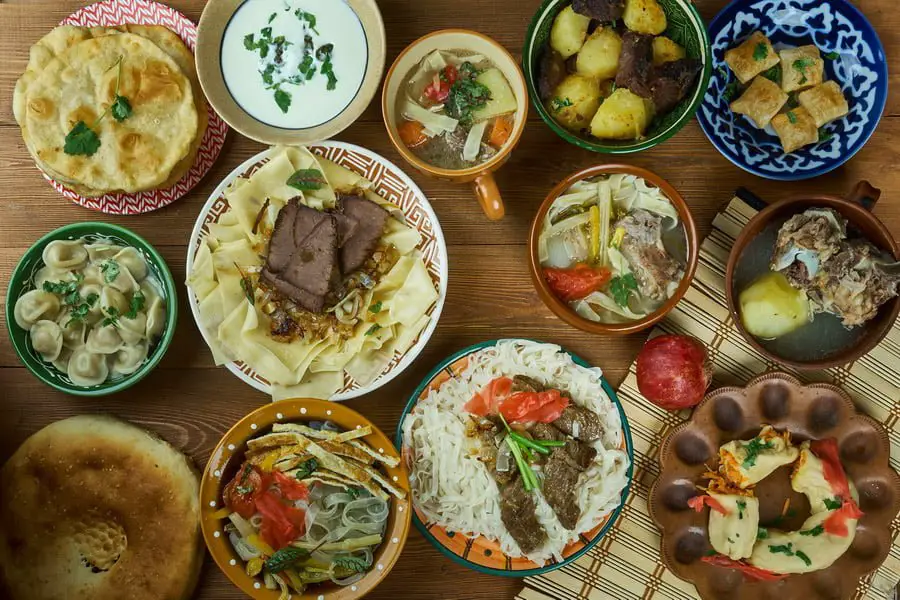Take Me to the Recipes
Located in the heart of Central Asia, surrounded by Kazakhstan, China, Tajikistan, and Uzbekistan, Kyrgyzstan is predominantly a mountainous region. The nation offers a continental climate characterized by cold winters and warm summers.
Kyrgyzstan boasts of picturesque landscapes, warm-hearted people, and a cuisine that is as rich as its culture. he close-knit community of around six million people takes immense pride in their culinary traditions, making Kyrgyz cuisine an exciting journey for the palate.
The sprawling terrains range from snowy peaks to vast rolling plains called “jailoos.” While the scenery might be a feast for the eyes, the primary industrial activity revolves around agriculture, animal husbandry, and mining.
Take Me to the Recipes
Kyrgyz Cuisine – Key Takeaways
- Central Asian nation known for its diverse landscapes and rich cultural heritage.
- The continental climate influences the agricultural produce, thereby shaping the cuisine.
- Agriculture and animal husbandry are the primary industrial activities.
- A population of around six million, with strong communal eating habits.
- Rich historical influences from its nomadic past.
- Kyrgyzstan cuisine is a harmonious blend of flavors, textures, and traditional cooking methods.
Where is Kyrgyzstan?

Kyrgyzstan, slightly smaller than South Dakota, is located along the eastern border of the Central Asian region, southeast of Kazakhstan, west of China, east of Uzbekistan, and north of Tajikistan.

Index of Contents
- Take Me to the Recipes
- More Articles
- Interesting Facts About Kyrgyzstan
- Kyrgyzstan History and the Effect it Has Had on the Kyrgyz food Recipes
- How Kyrgyzstan’s Climate and Geography has Influenced Kyrgyz Cuisine
- Understanding the Essence of Kyrgyz Cuisine
- How Healthy is Kyrgyz Cuisine?
- Kyrgyz food Recipes Traditions
- The National Food of Kyrgyzstan
- Popular Food in Kyrgyzstan
- Great Kyrgyz food Recipes to Try at Home
- Conclusion
- FAQ’s
You may also be interested in the following articles
- North and South American Cuisine – A Culinary Expedition
- Europe Cuisine: Savor the Continent’s Best Culinary Secrets!
- African Cuisine: Discover the Bold Flavors & Global Charm!
- Asian Cuisine Unlock its Secrets – Taste, Health & Global Influence!
Savor iconic Kyrgyz Recipes – Click on each tantalizing Image to open up the Recipe







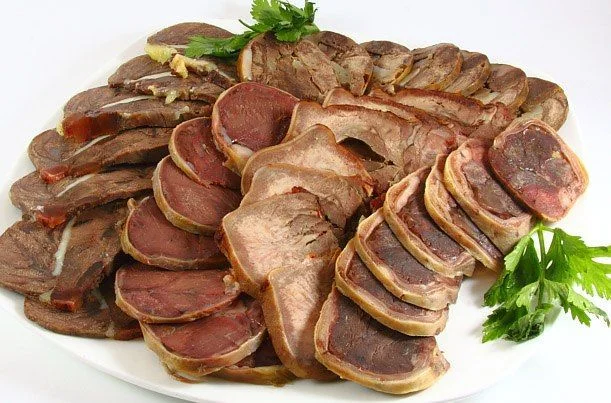
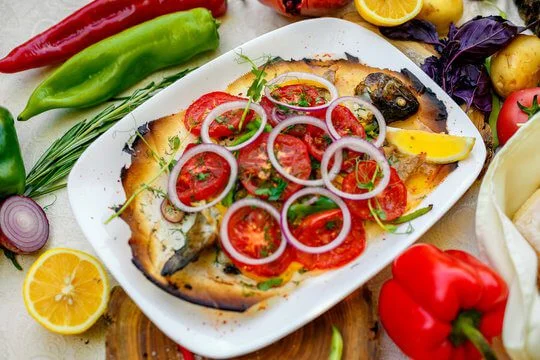




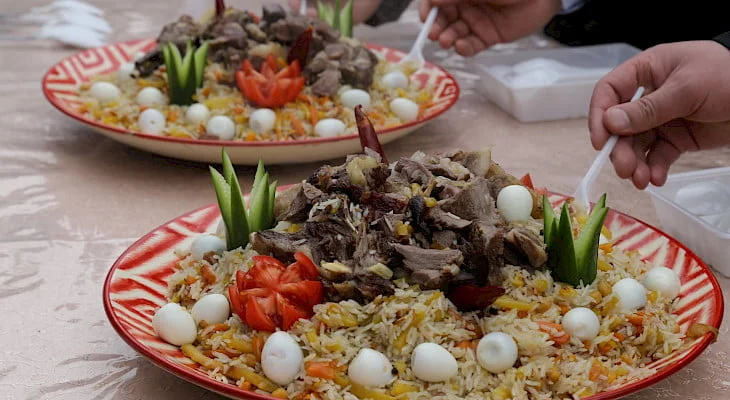
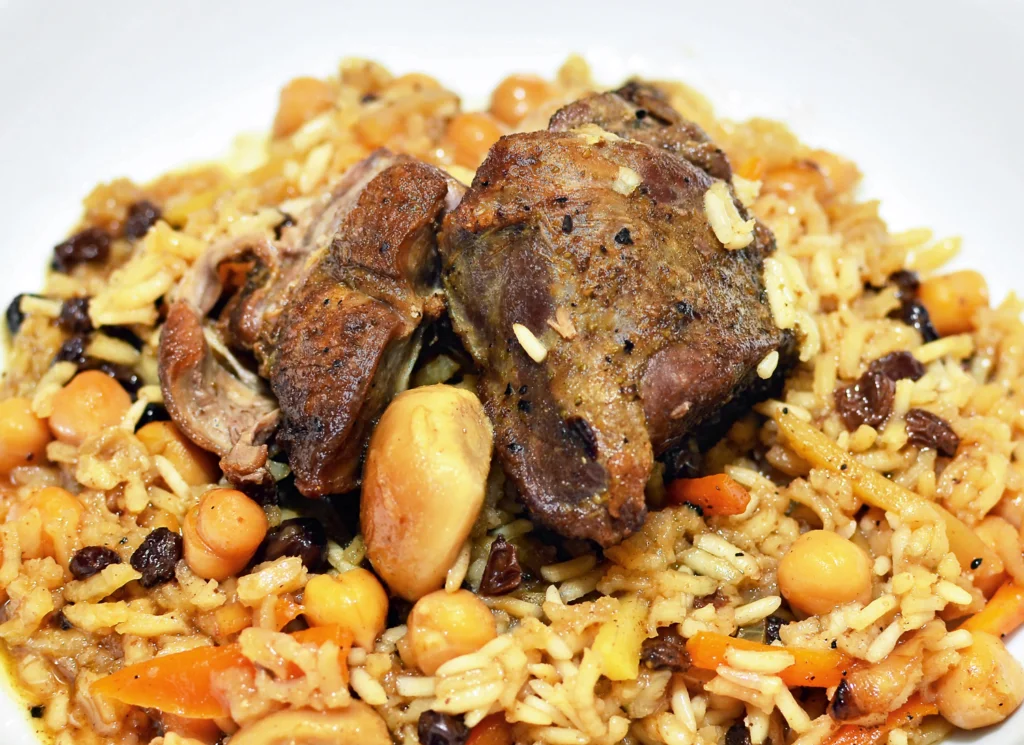
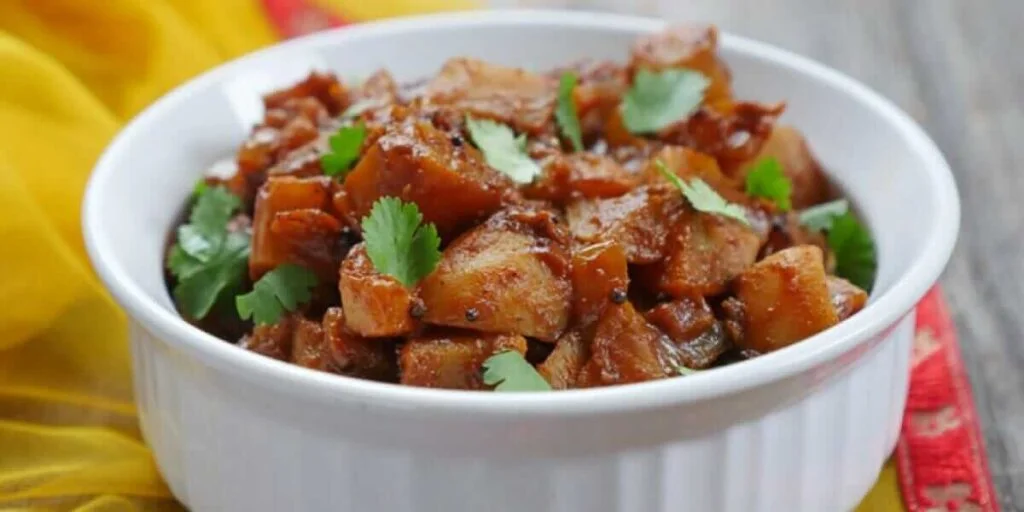

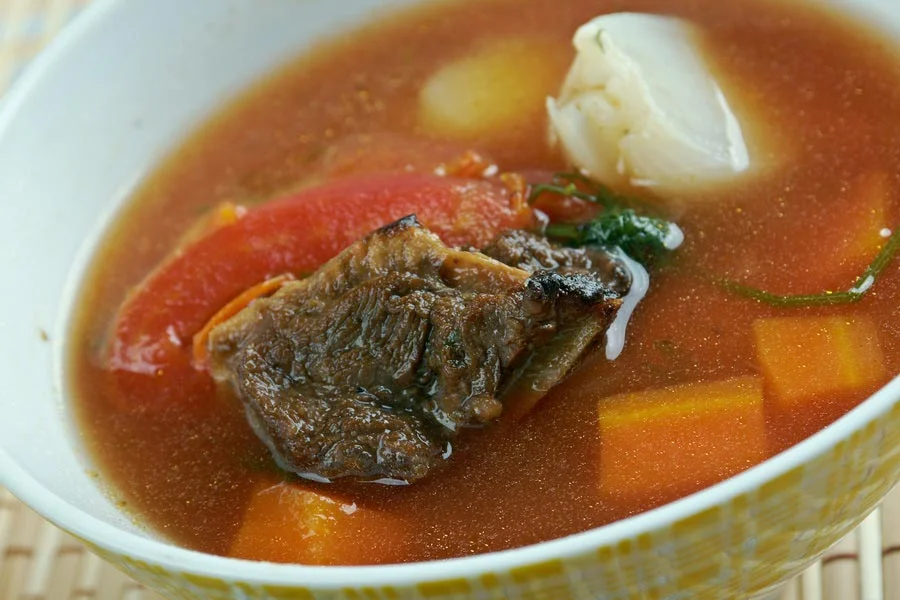


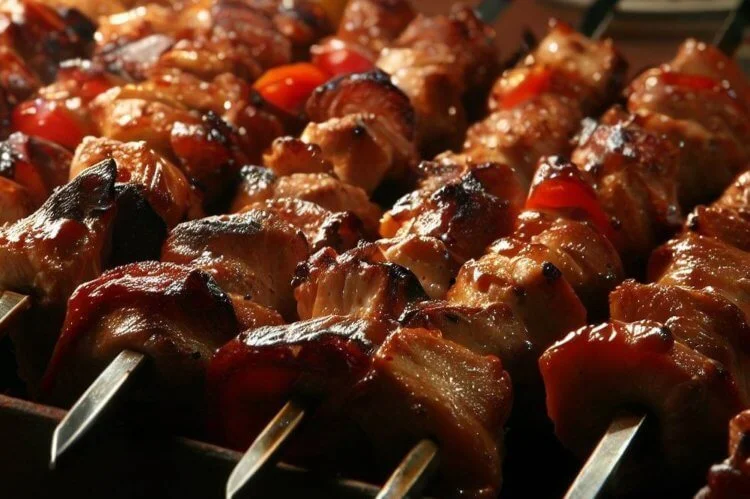
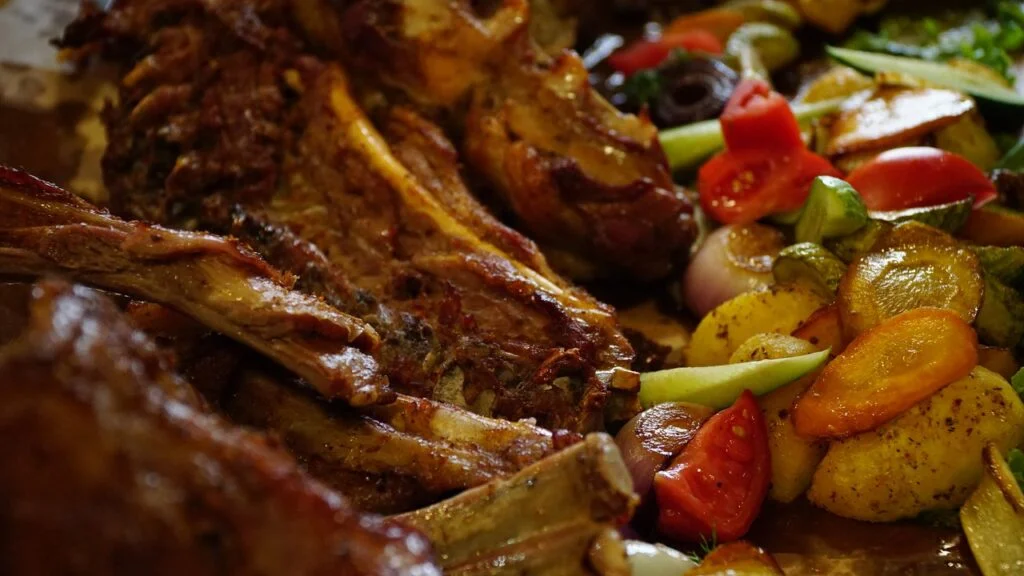
Interesting Facts About Kyrgyzstan
Discover the intriguing and unique aspects of Kyrgyzstan with these interesting and somewhat strange facts:
Land of Mountains

Kyrgyzstan is often referred to as the “Switzerland of Central Asia” due to its stunning mountainous landscapes, with 94% of its territory covered by mountains.
Nomadic Heritage
The traditional yurt, a portable and collapsible round tent, is an integral part of Kyrgyz culture. Nomadic herders historically used yurts, and they are still utilized for various purposes today.
World’s Second-Largest Alpine Lake

Issyk-Kul, the largest lake in Kyrgyzstan, is the second-largest alpine lake in the world. Surrounded by majestic mountains, it never freezes despite the cold temperatures.
Manas, the Epic Hero
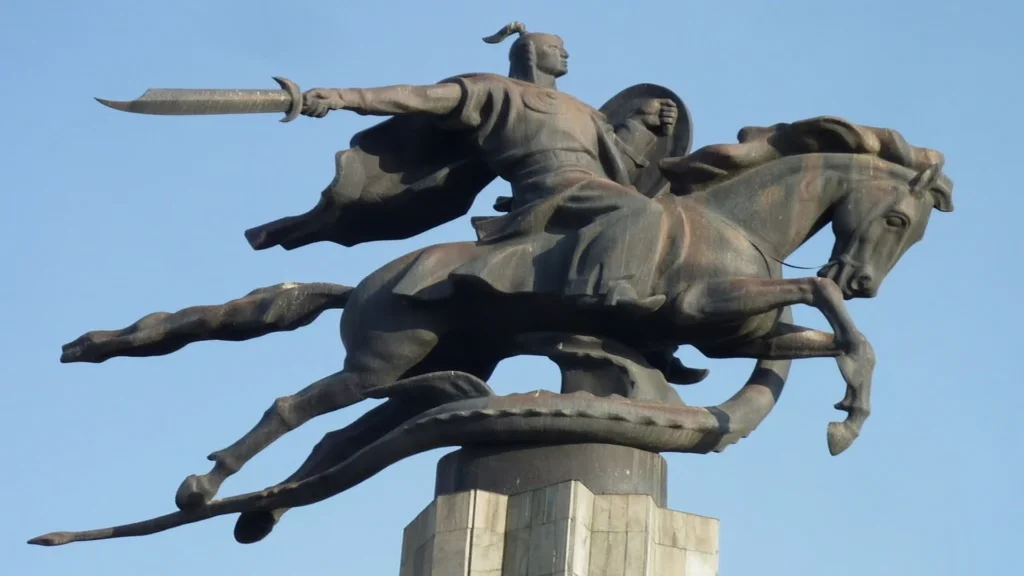
Kyrgyzstan’s national epic, the “Epic of Manas,” is one of the longest epics in the world. It tells the heroic tale of Manas, a legendary warrior, and reflects the country’s cultural identity.
No Prefix for Telephone Numbers
Kyrgyzstan is unique in that it doesn’t use a prefix for local telephone calls. When making a call within the same city, locals simply dial the phone number.
Independence Day Celebration

Independence Day in Kyrgyzstan is celebrated twice a year – on August 31st, marking independence from the Soviet Union, and on December 16th, celebrating independence from the Russian Empire.
World’s Second-Largest Walnut Forest

Arslanbob, located in southern Kyrgyzstan, is home to one of the world’s largest walnut forests. The ancient trees cover over 6,000 hectares and are a unique natural treasure.
Non-Biting Moscowitz

Tokmok, a town in northern Kyrgyzstan, is famous for its “non-biting mosquitoes.” While mosquitoes are present, locals humorously claim that they don’t bite.
Ritual Horse Games

Kok-Boru, a traditional Central Asian horse game, is a popular sport in Kyrgyzstan. In this game, two teams compete to score points by throwing a headless goat or calf into the opponent’s goal.
Sulaiman Too Sacred Mountain
Osh, one of Kyrgyzstan’s oldest cities, is home to Sulaiman Too, a sacred mountain that is also a UNESCO World Heritage Site. Legend has it that Prophet Solomon (Sulaiman) was buried at its summit.
Kyrgyzstan’s blend of natural wonders, cultural heritage, and unique traditions make it a captivating and somewhat quirky destination. These facts offer just a glimpse into the fascinating world of this Central Asian gem.
Kyrgyzstan History and the Effect it Has Had on the Kyrgyz food Recipes
Nestled in the heart of Central Asia, Kyrgyzstan boasts a rich history that has been significantly shaped by nomadic cultures, Silk Road trade, and various empires’ dominion. Its culinary traditions are a direct reflection of this intricate past, deeply influenced by its neighbors, topography, and historical events.
The nomadic heritage of the Kyrgyz people plays a central role in the nation’s cuisine. Living in the vast mountainous terrains, the early Kyrgyz relied heavily on livestock, resulting in meat-centric Kyrgyz food Recipes like “beshbarmak” – flat noodles with boiled meat, often sheep or horse, honoring the pastoral lifestyle.
The Great Silk Road

The great Silk Road, which traversed through Kyrgyzstan, brought a confluence of flavors, ingredients, and culinary techniques. Trade with Chinese, Persian, and Arab merchants introduced spices, grains, and unique preparation methods, enriching the local gastronomy.
Mongol dominance

Mongol dominance in the 13th century further diversified the Kyrgyz palate. Kyrgyz food Recipes like “manti” (dumplings filled with meat or pumpkin) and fermented dairy products showcase this Mongolian influence.
Russian annexation
Russian annexation in the late 19th century brought with it a new set of culinary traditions. Today, Kyrgyz households often serve Russian salads, soups, and pastries alongside traditional dishes.
Kyrgyzstan’s diverse ethnic groups
Kyrgyzstan’s diverse ethnic groups, including Uzbeks, Tajiks, and Dungans, have also contributed to the culinary tapestry. Each community added its flavors and techniques, resulting in a harmonious blend of dishes.
Central to Kyrgyz food Recipes is the communal aspect. Traditional gatherings, called “toi,” celebrate milestones with lavish spreads. Dishes like “kuurdak” (a meat stew) and “shorpo” (mutton soup) are must-haves, symbolizing warmth, hospitality, and unity.
In sum, Kyrgyz food Recipes are a delicious testament to its historical journey. Every dish tells a story of nomadic resilience, ancient trade routes, or cultural exchanges, making each meal a flavorful dive into the nation’s past.
How Kyrgyzstan’s Climate and Geography has Influenced Kyrgyz Cuisine

Kyrgyz cuisine is largely influenced by the climate and geography of Kyrgyzstan, a landlocked and mountainous country in Central Asia. Some of the main influences are:
Meat
Kyrgyzstan has a harsh continental climate, with cold winters and hot summers. This makes it difficult to grow crops and vegetables, but suitable for raising livestock, such as sheep, goats, cattle, horses, and yaks.
Meat is the main source of protein and calories for the Kyrgyz people, and is often preserved by salting, drying, or smoking. Some of the popular meat dishes in Kyrgyz cuisine are beshbarmak (boiled noodles with meat and broth), shashlik (grilled skewers of meat), and kazy (horse sausage)
Dairy
Dairy products are also an important part of Kyrgyz cuisine, as they provide calcium, fat, and vitamins. The Kyrgyz people make various kinds of cheese, yogurt, butter, and kumis (fermented mare’s milk) from the milk of their animals.
Dairy products are often consumed fresh, or stored in leather bags or clay pots for long periods. Some of the common dairy dishes in Kyrgyz cuisine are kurut (dried cheese balls), ayran (a yogurt drink), and chalap (a kumis drink with herbs).
Grains
Grains are the main source of carbohydrates and fiber for the Kyrgyz people, as they can grow in the valleys and foothills of the mountains. The most common grains are wheat, barley, and millet, which are used to make bread, porridge, and noodles.
Bread is a staple food in Kyrgyz cuisine and is often baked in a tandoor (a clay oven) or fried in oil. Some of the typical breads in Kyrgyz cuisine are nan (a round flatbread), boorsok (fried dough pieces), and katama (a layered flatbread with butter).
Fruits and vegetables
Fruits and vegetables are scarce and seasonal in Kyrgyzstan, due to the limited arable land and water resources. However, the Kyrgyz people make use of the fruits and vegetables that grow in their region, such as apples, apricots, plums, grapes, melons, carrots, potatoes, onions, and cabbage.
Fruits and vegetables are often eaten raw, cooked, or preserved by drying, pickling, or jamming. Some of the delicious fruit and vegetable dishes in Kyrgyz cuisine are morkovka (a carrot salad with garlic and vinegar), lagman (a noodle soup with vegetables and meat), and vareniki (dumplings with fruit or cheese filling).
In summary, Kyrgyz cuisine is influenced by the climate and geography of Kyrgyzstan, which determine the availability and diversity of food sources. The Kyrgyz people have adapted to their environment by using meat, dairy, grains, fruits, and vegetables in various ways to create a rich and flavorful culinary culture. 😊
References
Understanding the Essence of Kyrgyz Cuisine
Kyrgyzstan’s culinary tapestry is a testament to its vibrant past, deeply rooted in nomadic traditions, cross-cultural exchanges, and the unyielding landscapes of Central Asia. Kyrgyz cuisine, while infused with familiar flavors from neighboring nations, remains distinct, encapsulating the spirit and resilience of its people.
The pastoral essence is evident in the predominant use of meats, especially mutton and horse. “Beshbarmak,” meaning “five fingers,” is a celebrated dish, highlighting flat noodles and boiled meat, paying homage to the nation’s nomadic soul and symbolizing the customary way of eating with one’s hands.

Dairy, too, plays an instrumental role. Fermented products like “kumis” (mare’s milk) and “kefir” are staples, a nod to the herds that traverse the mountainous terrains. These, often consumed daily, are believed to offer strength and vitality.
The diverse landscape, from the fertile Fergana Valley to the rugged Tien Shan mountains, dictates the ingredients and techniques. Grains like barley, wheat, and millet thrive in these parts, resulting in hearty dishes that sustain against the harsh climatic conditions.
“Oromo,” a steamed dish of layered dough filled with meat, vegetables, or pumpkin, reflects the simplicity and nourishment crucial to the Kyrgyz diet. The influence of the Silk Road is tasted in the spices, with the subtle use of cumin, coriander, and pepper.
Yet, beyond individual dishes, the true essence of Kyrgyz cuisine lies in its communal nature. Traditional yurts become gathering spots, where meals are shared, stories told, and traditions passed on. Hospitality is paramount, with guests honored through elaborate feasts.
In essence, to understand Kyrgyz cuisine is to embrace its rich history, the interplay of diverse cultures, and the deep respect for the land and its bounty. It’s a culinary journey marked by simplicity, nourishment, and shared experiences.
The National Food of Kyrgyzstan

The national food of Kyrgyzstan is Beshbarmak. Beshbarmak, which translates to “five fingers” in Kyrgyz, is a traditional and iconic dish that reflects the country’s nomadic culture and love for hearty meals.
This culinary delight consists of boiled meat, usually lamb or beef, and a variety of accompanying elements. The dish is traditionally served on a large communal platter, and it brings people together for a shared dining experience.
How Healthy is Kyrgyz Cuisine?
Kyrgyz cuisine is a reflection of the nomadic and herding culture of the country. It is rich in meat, dairy, and bread, but not very diverse in fruits and vegetables.
Some of the dishes are very nutritious, such as plov, a rice dish with meat and carrots, or laghman, a noodle soup with vegetables and meat.
However, some of the dishes are also high in fat, salt, and cholesterol, such as beshbarmak, a pasta dish with horse or sheep meat, or kymyz, a fermented horse milk drink.
Kyrgyz cuisine also has some regional variations, depending on the availability of ingredients and the influence of neighboring countries. For example, fish is more common near the lakes and rivers, and dried fruits and nuts are more common in the south.
Overall, Kyrgyz cuisine can be healthy if eaten in moderation and balanced with other food groups. It is important to include more fresh fruits and vegetables, as well as lean sources of protein and whole grains, to prevent deficiencies and diseases.

According to a 2012 survey,
- 18 percent of children under 5 in Kyrgyzstan are stunted
- 43 percent of children under 5 and 35 percent of women aged 15–49 have some degree of anemia.
These are indicators of poor nutrition and health outcomes.
Therefore, strengthening nutrition within the Kyrgyz health system is a priority for improving the well-being of the population.
References
Kyrgyz food Recipes Traditions
Kyrgyzstan, a land of high mountains and vast steppes, offers a culinary heritage deeply rooted in nomadic lifestyles and the rhythms of nature. The culinary traditions of the Kyrgyz people are a blend of ancient practices, seasonal ingredients, and cultural exchanges.

At the heart of Kyrgyz cuisine is the reverence for livestock. Animals like sheep, cattle, and horses not only provide transportation and labor but also form the basis for many traditional dishes. “Beshbarmak,” which translates to ‘five fingers,’ is a beloved dish made of boiled meat and noodles, symbolizing the Kyrgyz practice of eating with one’s hands.
Horse meat holds a special place in Kyrgyz food Recipes traditions. “Kazy” and “chuchuk,” types of horse sausages, are often served during significant gatherings, representing strength and endurance.
Dairy products derived from mares, cows, and sheep are essential. “Kumis,” a mildly alcoholic beverage made from fermented mare’s milk, is considered both a drink and a medicine, believed to possess healing properties. “Suzma” and “kurut” are other dairy products, showcasing the ability to preserve food for long winters and journeys.
The traditional yurt gatherings, or “toi,” are where these culinary practices truly come alive. A sense of community and hospitality is at the forefront, with guests treated to an array of dishes.
Neighboring Country Influences
Influences from neighboring China and Central Asian countries are evident in dishes like “manti” (dumplings) and “laghman” (noodle soup). The Silk Road’s legacy can be tasted in the spices and flavors introduced over the centuries.
Sweets, though less predominant, find their place in rituals and celebrations. “Chak-chak,” honey-soaked fried dough balls, and dried fruits are popular treats.
In summary, Kyrgyz food Recipes traditions are a testament to the harmony between man, animal, and nature. They celebrate resilience, adaptability, and the deep communal bonds that have sustained the Kyrgyz people through the ages.
Popular Food in Kyrgyzstan
Kyrgyzstan offers a rich tapestry of flavors in its culinary landscape, influenced by its nomadic traditions and the diverse ethnic groups that call the country home. Here are some popular foods in Kyrgyzstan:

Beshbarmak
- Description: Beshbarmak, meaning “five fingers,” is a traditional Kyrgyz dish featuring boiled meat (usually lamb or beef), served with flatbread and accompanied by boiled vegetables.
- Key Ingredients: Meat, flatbread, potatoes, carrots, onions, and various seasonings.
- Notes: A symbol of hospitality, Beshbarmak is often shared among family and friends on special occasions.
Manti
- Description: Manti are dumplings filled with minced meat (typically lamb or beef) and onions. They are either steamed or boiled and served with yogurt or sour cream.
- Key Ingredients: Minced meat, onions, flour, water, and spices.
- Notes: Manti are a popular comfort food and are enjoyed during celebrations and family gatherings.
Laghman
- Description: Laghman is a noodle dish with a savory stir-fried topping that includes meat, vegetables, and a flavorful sauce.
- Key Ingredients: Hand-pulled noodles, meat (often lamb), bell peppers, carrots, onions, and spices.
- Notes: Laghman showcases Central Asian influences, and its preparation can vary across the region.
Shashlik
- Description: Shashlik consists of skewered and grilled meat, usually marinated in a mixture of spices and oil.
- Key Ingredients: Meat (commonly lamb, beef, or chicken), marinade with spices.
- Notes: A popular street food and a favorite for outdoor gatherings and celebrations.
Kuurdak
- Description: Kuurdak is a hearty dish made by frying and then simmering meat (often beef or mutton) with potatoes and onions.
- Key Ingredients: Meat, potatoes, onions, oil, and spices.
- Notes: Kuurdak is known for its robust flavors and is a filling and satisfying meal.
Samsa
- Description: Samsa is a pastry filled with minced meat (usually lamb or beef), onions, and various spices. It is baked until golden and flaky.
- Key Ingredients: Minced meat, onions, flour, water, and spices.
- Notes: Samsa is a popular snack and is often enjoyed with tea.
Kyrgyz cuisine reflects the country’s nomadic history and the influence of the Silk Road, offering a delightful array of dishes that capture the essence of Central Asian flavors.
Great Kyrgyz food Recipes to Try at Home
The culinary landscape of Kyrgyzstan is a delightful blend of its nomadic past and the influences from its neighbors.
Rooted deeply in traditions, the Kyrgyz people have dishes that reflect their history, environment, and lifestyle. From hearty meat dishes that provide warmth during cold winters to light and refreshing salads for summers, Kyrgyzstan cuisine has something for every palate.
Kazakhstan Food – Oromo (Kyrgyz Dumpling)

History and Background: Kazakhstan’s rich culinary tapestry offers a delightful dish called Oromo, a traditional Kyrgyz dumpling that has found its way into the hearts and homes of many. Originating from the nomadic lifestyle of the Kyrgyz people, Oromo represents a harmonious blend of flavors and practicality.
This dish, shaped like a half-moon, reflects the cultural heritage and communal spirit of the region. Oromo has become a staple in Central Asian households, showcasing the influence of nomadic traditions on the culinary landscape.
Kazakhstan Food – Ingredients
- 2 cups all-purpose flour
- 1 cup warm water
- 300g ground meat (beef or lamb)
- 1 onion, finely chopped
- 2 potatoes, grated
- Salt and pepper to taste
- Vegetable oil for cooking
Kazakhstan Food – Recipe
1. Prepare the Dough:
- In a large mixing bowl, combine the flour and warm water.
- Knead the mixture until it forms a smooth, elastic dough.
- Cover the dough and let it rest for about 30 minutes.
2. Prepare the Filling:
- In a separate bowl, mix the ground meat, finely chopped onion, grated potatoes, salt, and pepper.
- Ensure the ingredients are well combined to create a flavorful filling.
3. Shape the Dumplings:
- Divide the rested dough into small portions.
- Roll each portion into a thin, circular disc, about the size of a small plate.
- Place a generous spoonful of the meat and potato filling on one half of the dough circle.
4. Fold and Seal:
- Carefully fold the other half of the dough over the filling, creating a half-moon shape.
- Press the edges together to seal the dumpling, ensuring no filling escapes during cooking.
5. Cook the Oromo:
- Heat vegetable oil in a pan over medium heat.
- Place the dumplings in the pan and cook until both sides are golden brown.
- Ensure the meat is cooked thoroughly by checking for doneness.
6. Serve and Enjoy:
- Oromo is best served hot, straight from the pan.
- Pair it with yogurt or a simple dipping sauce for added flavor.
Serving Information:
- Serves: 4 people
- Cooking Time: Approximately 45 minutes
- Calories: Nutritional content may vary based on specific ingredients and portion sizes.
Oromo, with its tender dough and savory filling, brings the essence of Central Asian cuisine to your table. This delightful dish invites you to savor the flavors of Kazakhstan’s nomadic history.
Kazakhstan Food – Airan, Chalap

History and Background: Embark on a culinary journey to Kazakhstan with Airan and Chalap, refreshing dairy-based delights deeply rooted in Central Asian traditions. Originating from the nomadic lifestyle of the region, these beverages are a testament to the ingenious use of simple, locally available ingredients.
Airan, a classic yogurt drink, and Chalap, a cultured milk beverage, not only offer a cooling respite in the Kazakh steppe but also showcase the cultural significance of dairy in the nomadic diet.
Kazakhstan Food – Ingredients: For Airan
- 2 cups plain yogurt
- 1 cup cold water
- 1 teaspoon salt
- Fresh mint leaves (optional for garnish)
For Chalap:
- 2 cups cultured milk (kefir or similar)
- 1 cup cold water
- 1 teaspoon salt
- Fresh herbs (such as dill or cilantro, optional for garnish)
Kazakhstan Food – Recipe
1. Prepare Airan: Ingredients:
- 2 cups plain yogurt
- 1 cup cold water
- 1 teaspoon salt
Steps:
- In a mixing bowl, combine the plain yogurt, cold water, and salt.
- Whisk the mixture until it becomes smooth and well-blended.
- Refrigerate the Airan for at least 1 hour to enhance its refreshing taste.
2. Prepare Chalap: Ingredients:
- 2 cups cultured milk (kefir or similar)
- 1 cup cold water
- 1 teaspoon salt
Steps:
- In a separate mixing bowl, mix the cultured milk, cold water, and salt.
- Stir until the ingredients are thoroughly combined.
- Chill the Chalap in the refrigerator for at least 1 hour to allow the flavors to meld.
3. Serve and Garnish: For Airan:
- Pour the chilled Airan into glasses.
- Garnish with fresh mint leaves if desired.
- Serve immediately for a cool and tangy treat.
For Chalap:
- Pour the chilled Chalap into glasses.
- Garnish with fresh herbs like dill or cilantro if desired.
- Enjoy the cultured goodness of Chalap as a nourishing beverage.
Serving Information:
- Serves: 2 people
- Preparation Time: Approximately 10 minutes
- Chilling Time: 1 hour
- Calories: Nutritional content may vary based on specific ingredients and portion sizes.
Airan and Chalap not only offer a taste of Kazakhstan but also provide a glimpse into the nomadic traditions that continue to influence the country’s culinary landscape. Cheers to a sip of Kazakh refreshment!
Kazakhstan Food – Jarkop

History and Background: Embark on a culinary adventure to Kazakhstan with Jarkop, a savory meat and vegetable stew that reflects the hearty flavors of Central Asian cuisine. Originating from the nomadic traditions of the region, Jarkop has evolved into a beloved dish that warms the hearts and bellies of those who enjoy it.
The combination of tender meat, vibrant vegetables, and fragrant spices showcases the cultural richness and resourcefulness of Kazakhstan’s culinary heritage.
Kazakhstan Food – Jarkop Ingredients
- 500g beef or lamb, cubed
- 2 large potatoes, diced
- 2 carrots, sliced
- 1 onion, finely chopped
- 1 bell pepper, diced
- 2 tomatoes, chopped
- 3 cloves garlic, minced
- 2 tablespoons vegetable oil
- 1 teaspoon cumin
- 1 teaspoon paprika
- Salt and pepper to taste
- Fresh parsley for garnish
Kazakhstan Food – Jarkop Recipe
1. Prepare the Ingredients: Ingredients:
- 500g beef or lamb, cubed
- 2 large potatoes, diced
- 2 carrots, sliced
- 1 onion, finely chopped
- 1 bell pepper, diced
- 2 tomatoes, chopped
- 3 cloves garlic, minced
Steps:
- Ensure all vegetables are cleaned, peeled, and chopped as specified.
2. Sauté the Aromatics: Ingredients:
- 2 tablespoons vegetable oil
- 1 onion, finely chopped
- 3 cloves garlic, minced
Steps:
- In a large pot, heat vegetable oil over medium heat.
- Sauté the chopped onion and minced garlic until fragrant and golden.
3. Brown the Meat: Ingredients:
- 500g beef or lamb, cubed
Steps:
- Add the cubed meat to the pot and brown on all sides.
4. Add Vegetables and Spices: Ingredients:
- 2 large potatoes, diced
- 2 carrots, sliced
- 1 bell pepper, diced
- 2 tomatoes, chopped
- 1 teaspoon cumin
- 1 teaspoon paprika
- Salt and pepper to taste
Steps:
- Mix in the diced potatoes, sliced carrots, diced bell pepper, and chopped tomatoes.
- Season with cumin, paprika, salt, and pepper. Stir well to combine.
5. Simmer to Perfection: Steps:
- Pour enough water to cover the ingredients.
- Bring the stew to a boil, then reduce heat and simmer until the meat is tender and the vegetables are cooked.
6. Garnish and Serve: Ingredients:
- Fresh parsley for garnish
Steps:
- Garnish the Jarkop with fresh parsley.
- Serve the stew hot, allowing its flavors to delight your taste buds.
Serving Information:
- Serves: 4 people
- Cooking Time: Approximately 1 hour
- Calories: Nutritional content may vary based on specific ingredients and portion sizes.
Jarkop brings the essence of Kazakhstan to your table – a savory journey through the flavors of the Central Asian steppe. Enjoy this hearty stew that pays homage to the country’s nomadic culinary heritage.
Kazakhstan Food – Plov

History and Background of Kazakh Plov
Welcome back to my cozy kitchen, foodies! Today, we’re taking a flavorful journey to the heart of Central Asia with a dish that holds a special place in my culinary repertoire – Kazakh Plov. Originating from the nomadic traditions of Kazakhstan, Plov is a beloved one-pot rice dish that reflects the rich cultural tapestry of the region.
The dish has deep roots in the nomadic lifestyle, where hearty and wholesome meals were essential for sustaining energy during long journeys across the vast landscapes of Central Asia.
Kazakhstan Food – Ingredients for Kazakh Plov (Serves 4)
- 1 lb lamb, diced
- 2 cups long-grain rice
- 1 large onion, finely chopped
- 3 medium carrots, julienned
- 1/2 cup vegetable oil
- 4 cloves garlic, minced
- 1 teaspoon cumin seeds
- 1 teaspoon coriander powder
- 1 teaspoon paprika
- 1 bay leaf
- Salt and pepper to taste
- 4 cups beef or vegetable broth
- Fresh parsley for garnish
Kazakhstan Food – Recipe for Kazakh Plov
Prep and Sauté
- Heat vegetable oil in a large, heavy-bottomed pot over medium heat.
- Add diced lamb and brown on all sides. Season with salt, pepper, cumin seeds, coriander powder, and paprika.
- Stir in chopped onions and minced garlic. Sauté until onions are translucent.
Add Vegetables
- Add julienned carrots to the pot. Stir and cook until the carrots start to soften.
- Pour in the rice and continue stirring for 2-3 minutes, ensuring the rice is well-coated with the aromatic mixture.
Simmer
- Pour in the beef or vegetable broth and add the bay leaf. Bring the mixture to a boil.
- Once boiling, reduce heat to low, cover, and simmer for 20-25 minutes or until rice is cooked and liquid is absorbed.
Garnish and Serve
- Fluff the cooked rice with a fork, mixing in the lamb and vegetables.
- Garnish with fresh parsley and serve hot.
Cooking Time: Approximately 45 minutes
Nutritional Information (per serving):
- Calories: 550
- Protein: 25g
- Fat: 20g
- Carbohydrates: 70g
- Fiber: 4g
I hope you enjoy this delightful taste of Kazakhstan in your own kitchen! Don’t forget to share your creations and tag me in your photos. Happy cooking!
Kazakhstan Food – Shirin Paloo

History and Background of Kazakh Shirin Paloo
Hey there, food enthusiasts! Today, we’re diving into the vibrant culinary world of Kazakhstan with a dish that brings joy to every bite – Shirin Paloo. Originating from the heart of Central Asia, this delightful dish is a celebration of flavors that have been cherished for generations.
Kazakh Shirin Paloo is a sweet and savory rice dish, symbolizing the rich cultural tapestry of the region. With a history rooted in nomadic traditions, this dish reflects the warmth and hospitality of the Kazakh people.
Kazakhstan Food – Ingredients for Kazakh Shirin Paloo (Serves 6):
- 2 cups Basmati rice
- 1 lb lamb, cubed
- 1 large onion, finely chopped
- 1 cup dried apricots, chopped
- 1 cup raisins
- 1/2 cup vegetable oil
- 1 teaspoon ground cinnamon
- 1 teaspoon ground cumin
- 1 teaspoon salt
- 1/2 teaspoon black pepper
- 4 cups water or broth
- Fresh cilantro for garnish
Kazakhstan Food – Recipe for Kazakh Shirin Paloo:
Rinse and Soak Rice
- Rinse the Basmati rice under cold water until the water runs clear.
- Soak the rice in water for 30 minutes, then drain.
Sauté Lamb and Onions
- Heat vegetable oil in a large pot over medium heat.
- Add cubed lamb and cook until browned on all sides.
- Add finely chopped onions and sauté until they become translucent.
Add Spices and Fruits
- Stir in ground cinnamon, ground cumin, salt, and black pepper.
- Add dried apricots and raisins, mixing well with the lamb and onion mixture.
Cook the Rice
- Add the soaked and drained rice to the pot, stirring gently to combine with the other ingredients.
- Pour in water or broth and bring the mixture to a boil.
- Reduce heat to low, cover, and simmer for 15-20 minutes or until rice is tender and the liquid is absorbed.
Garnish and Serve
- Fluff the cooked rice with a fork and garnish with fresh cilantro.
- Serve hot and enjoy the sweet and savory goodness!
Cooking Time: Approximately 1 hour
Nutritional Information (per serving):
- Calories: 450
- Protein: 20g
- Fat: 15g
- Carbohydrates: 60g
- Fiber: 4g
I hope this delightful journey into Kazakh cuisine adds a burst of flavor to your home cooking adventures. Share your delicious creations, and let’s keep the culinary love alive! Happy cooking!
Kazakhstan Food – Shorpo

History and Background of Kazakh Shorpo
Greetings, food enthusiasts! Today, let’s embark on a culinary adventure to Kazakhstan with a hearty and soul-warming dish known as Shorpo. Originating from the vast and picturesque landscapes of Central Asia, Shorpo is a traditional Kazakh soup that has been cherished for centuries.
It’s a dish deeply rooted in nomadic culture, where the need for hearty and nourishing meals is essential for the harsh climate. Shorpo reflects the warmth and resilience of the Kazakh people, making it a true comfort food that brings communities together.
Kazakhstan Food – Ingredients for Kazakh Shorpo (Serves 4):
- 1 lb lamb, cut into chunks
- 1 lb potatoes, peeled and diced
- 2 carrots, sliced
- 1 onion, finely chopped
- 3 cloves garlic, minced
- 1 bay leaf
- 1 teaspoon black peppercorns
- Salt to taste
- Fresh dill for garnish
- 8 cups water
Kazakhstan Food – Recipe for Kazakh Shorpo:
Prep the Ingredients
- Cut lamb into bite-sized chunks.
- Peel and dice the potatoes.
- Slice the carrots, finely chop the onion, and mince the garlic.
Boil the Lamb
- In a large pot, bring 8 cups of water to a boil.
- Add lamb chunks, bay leaf, black peppercorns, and salt.
- Simmer for 30-40 minutes, skimming off any foam that rises to the surface.
Add Vegetables
- Add diced potatoes, sliced carrots, chopped onion, and minced garlic to the pot.
- Continue simmering for an additional 20-25 minutes or until vegetables are tender.
Garnish and Serve
- Remove the bay leaf and discard.
- Ladle the hot Shorpo into bowls, garnish with fresh dill, and serve immediately.
Cooking Time: Approximately 1 hour and 15 minutes
Nutritional Information (per serving):
- Calories: 320
- Protein: 22g
- Fat: 12g
- Carbohydrates: 28g
- Fiber: 4g
Warm up your kitchen with the comforting aroma of Shorpo, and let the rich flavors transport you to the heart of Kazakhstan. Don’t forget to share your kitchen adventures with me! Happy cooking!
Kazakhstan Food – Stuffed Green Peppers

History and Background of Kazakh Stuffed Green Peppers
Hello, fellow food enthusiasts! Today, we’re exploring the culinary delights of Kazakhstan with a classic and comforting dish – Stuffed Green Peppers. This recipe has its roots in the rich tapestry of Central Asian cuisine, reflecting the Kazakh tradition of incorporating locally available ingredients into hearty meals.
Stuffed Green Peppers offer a taste of home, combining the warmth of spices with the freshness of vegetables, making it a beloved and satisfying dish in Kazakh households.
Kazakhstan Food – Ingredients for Kazakh Stuffed Green Peppers (Serves 6):
- 6 large green bell peppers
- 1 lb ground beef
- 1 cup rice, uncooked
- 1 large onion, finely chopped
- 2 cloves garlic, minced
- 1 can (14 oz) crushed tomatoes
- 1 teaspoon cumin
- 1 teaspoon paprika
- Salt and pepper to taste
- 2 cups beef or vegetable broth
- Chopped fresh parsley for garnish
Kazakhstan Food -Recipe for Kazakh Stuffed Green Peppers:
Prep the Peppers
- Cut the tops off the green peppers and remove the seeds.
- Blanch the peppers in boiling water for 3-4 minutes, then set aside.
Prepare the Filling
- In a large bowl, mix ground beef, uncooked rice, finely chopped onion, minced garlic, cumin, paprika, salt, and pepper.
- Stuff each blanched green pepper with the beef and rice mixture.
Arrange in a Pot
- In a deep pot, arrange the stuffed peppers.
- Pour crushed tomatoes and beef or vegetable broth over the peppers.
Cook
- Cover the pot and simmer over medium-low heat for 40-45 minutes or until the rice is cooked and the peppers are tender.
Garnish and Serve
- Sprinkle chopped fresh parsley over the stuffed peppers before serving.
- Enjoy these hearty and flavorful Stuffed Green Peppers hot!
Cooking Time: Approximately 1 hour
Nutritional Information (per serving):
- Calories: 350
- Protein: 20g
- Fat: 12g
- Carbohydrates: 35g
- Fiber: 4g
Bring the taste of Kazakhstan to your table with these delicious Stuffed Green Peppers. Share your experiences and tag me in your creations! Happy cooking!
Kazakhstan Food – Tash-Kordo

Exploring Tash-Kordo: A Culinary Journey through Kazakh Flavors
Welcome back to my cozy kitchen, fellow food enthusiasts! Today, I’m thrilled to share a delightful recipe that takes us on a virtual trip to the heart of Kazakhstan. Our star dish is Tash-Kordo, a traditional Kazakh delight that perfectly captures the essence of Central Asian cuisine.
Originating from the vast and diverse landscapes of Kazakhstan, Tash-Kordo is a savory and aromatic dish that has been passed down through generations, reflecting the rich culinary heritage of the region.
Kazakhstan Food Tash-Kordo – Ingredients
Prepare your taste buds for a symphony of flavors with these authentic ingredients:
- 2 cups lamb, diced
- 1 cup carrots, finely chopped
- 1 cup onions, diced
- 1 cup potatoes, cubed
- 1 cup tomatoes, crushed
- 1/2 cup vegetable oil
- 3 cloves garlic, minced
- 1 teaspoon ground cumin
- 1 teaspoon paprika
- Salt and pepper to taste
- 4 cups beef or vegetable broth
- Fresh parsley for garnish
Kazakhstan Food Tash-Kordo – Recipe:
Prep Work
- In a large pot, heat the vegetable oil over medium heat.
- Add the diced lamb and brown it until golden on all sides.
- Toss in the minced garlic, diced onions, and finely chopped carrots. Sauté until the vegetables are tender.
Spice it Up
- Sprinkle ground cumin, paprika, salt, and pepper over the lamb and vegetables.
- Stir well to ensure the spices coat the ingredients evenly.
The Heart of Tash-Kordo
- Add the cubed potatoes and crushed tomatoes to the pot.
- Pour in the beef or vegetable broth, bringing the mixture to a gentle boil.
Simmer and Savor
- Reduce the heat to low and let the Tash-Kordo simmer for about 30-40 minutes or until the lamb and vegetables are tender.
- Taste and adjust the seasoning if needed.
Garnish and Serve
- Ladle the hot Tash-Kordo into bowls and garnish with fresh parsley.
- Serve this hearty dish with your favorite bread or enjoy it on its own!
Serving Information:
- This Tash-Kordo recipe serves 4 people.
- Estimated Cooking Time: 1 hour (including prep and simmering).
Nutritional Information (Per Serving):
- Calories: 420 kcal
- Protein: 25g
- Fat: 20g
- Carbohydrates: 35g
- Fiber: 6g
- Sugar: 8g
I hope you enjoy this taste of Kazakhstan in the comfort of your own home. Stay tuned for more culinary adventures, and happy cooking!
Kazakhstan Food – Shishkebe

Discovering Shishkebe: A Flavorful Journey into Kazakh Cuisine
Welcome back, foodies! Today, we’re diving into the vibrant culinary tapestry of Kazakhstan with a recipe that’s sure to tickle your taste buds – Shishkebe. Originating from the nomadic traditions of the Kazakh people,
Shishkebe is a grilled meat skewer that encapsulates the essence of Central Asian flavors. This dish has been a staple in Kazakh culture for centuries, reflecting the nomadic lifestyle and the resourcefulness of using simple, yet delicious ingredients.
Ingredients:
Get ready for a mouthwatering experience with these essential ingredients:
- 2 pounds beef or lamb, cubed
- 1 cup plain yogurt
- 1/4 cup vegetable oil
- 2 tablespoons tomato paste
- 2 cloves garlic, minced
- 1 teaspoon ground cumin
- 1 teaspoon paprika
- Salt and pepper to taste
- Bell peppers, onions, and cherry tomatoes for skewering
Kazakhstan Food – Shishkebe Recipe
Marinating the Meat
- In a bowl, mix together yogurt, vegetable oil, tomato paste, minced garlic, ground cumin, paprika, salt, and pepper.
- Add the cubed meat, ensuring it’s well-coated in the flavorful marinade.
- Cover the bowl and let it marinate in the refrigerator for at least 2 hours, or overnight for maximum flavor.
Skewering the Goodness
- Preheat your grill or oven to medium-high heat.
- Thread the marinated meat onto skewers, alternating with bell peppers, onions, and cherry tomatoes.
Grilling to Perfection
- Grill the skewers for about 10-15 minutes, turning occasionally, until the meat is cooked to your desired level of doneness.
- Baste the skewers with any remaining marinade during the grilling process for extra flavor.
Serve and Enjoy
- Once grilled to perfection, serve the Shishkebe skewers hot.
- Pair it with your favorite side dishes or a simple salad for a complete meal.
Serving Information:
- This Shishkebe recipe serves 4 people.
- Estimated Cooking Time: 30 minutes (plus marinating time).
Nutritional Information (Per Serving):
- Calories: 380 kcal
- Protein: 30g
- Fat: 22g
- Carbohydrates: 12g
- Fiber: 2g
- Sugar: 6g
Get ready to savor the flavors of Kazakhstan in the comfort of your own kitchen. Grill up these Shishkebe skewers for a taste of nomadic tradition that’s both delicious and culturally rich. Happy grilling!
Kazakhstan Food – Oromo

Journeying into Kazakh Tradition with Oromo: A Tasty Heritage
Welcome back to my kitchen, fellow foodies! Today, we’re taking a culinary expedition to Kazakhstan, exploring the roots of a delightful dish called Oromo. Originating from the vast landscapes and nomadic traditions of Central Asia, Oromo is a cherished recipe that has been passed down through generations.
This savory dish represents the heart and soul of Kazakh cuisine, bringing together simple yet flavorful ingredients in a celebration of culinary heritage.
Kazakhstan Food – Oromo Ingredients
Prepare to embark on a flavorful adventure with these authentic Oromo ingredients:
- 2 cups all-purpose flour
- 1 cup warm water
- 1 teaspoon salt
- 1 pound beef or lamb, finely minced
- 1 onion, finely chopped
- 2 tablespoons vegetable oil
- Salt and pepper to taste
- Fresh herbs for garnish (dill or parsley)
Kazakhstan Food – Oromo Recipe
Crafting the Dough
- In a large bowl, combine the all-purpose flour, warm water, and salt.
- Knead the mixture until a soft, elastic dough forms. Let it rest for 15-20 minutes.
Preparing the Filling
- In a skillet, heat vegetable oil over medium heat.
- Add the finely chopped onion and cook until it turns golden brown.
- Add the minced beef or lamb, seasoning with salt and pepper. Cook until the meat is browned.
Assembling the Oromo
- Divide the dough into small balls and roll each one into a thin circle on a floured surface.
- Place a portion of the cooked meat filling in the center of each dough circle.
Folding and Sealing
- Fold the edges of the dough over the filling to create a semi-circular shape.
- Press the edges firmly to seal the Oromo pockets.
Cooking to Perfection
- Preheat your oven to 375°F (190°C).
- Bake the Oromo for 20-25 minutes or until the crust is golden brown and the filling is cooked through.
Garnish and Serve
- Sprinkle fresh herbs like dill or parsley over the Oromo before serving.
- Enjoy these delicious pockets of Kazakh tradition hot from the oven!
Serving Information:
- This Oromo recipe serves 4 people.
- Estimated Cooking Time: 1 hour (including dough resting and baking).
Nutritional Information (Per Serving):
- Calories: 380 kcal
- Protein: 20g
- Fat: 15g
- Carbohydrates: 45g
- Fiber: 2g
- Sugar: 1g
Take a seat at your table and savor the flavors of Kazakhstan with this Oromo recipe. A perfect blend of history and taste, it’s a delightful dish that brings the spirit of Central Asia to your home kitchen. Happy cooking!
Kazakhstan Food – Hoshany

Unveiling Hoshany: A Culinary Tale from the Steppes of Kazakhstan
Welcome back to my kitchen, dear foodies! Today, we’re delving into the rich culinary tapestry of Kazakhstan with a delightful dish called Hoshany. This traditional Kazakh recipe has its roots in the nomadic lifestyle of the region, where hearty and flavorful dishes like Hoshany have been a staple for generations.
Let’s explore the history, savor the unique ingredients, and learn to create this delicious piece of Kazakh heritage.
Kazakhstan Food – Hoshany Ingredients
Embark on this flavor-filled journey with these essential Hoshany ingredients:
- 2 cups beef or lamb, thinly sliced
- 1 cup onions, finely chopped
- 1 cup carrots, julienned
- 1 cup bell peppers, thinly sliced
- 1 cup tomatoes, diced
- 1/2 cup vegetable oil
- 2 cloves garlic, minced
- 1 teaspoon ground cumin
- 1 teaspoon paprika
- Salt and pepper to taste
- Fresh herbs for garnish (chives or cilantro)
- 4 cups cooked rice for serving
Kazakhstan Food – Hoshany Recipe
Searing the Meat
- In a large skillet, heat vegetable oil over medium heat.
- Add the thinly sliced beef or lamb, searing until browned on all sides.
Creating the Flavor Base
- Stir in the minced garlic, finely chopped onions, and julienned carrots.
- Cook until the vegetables are softened and the onions turn translucent.
Adding Vibrant Colors
- Introduce the thinly sliced bell peppers and diced tomatoes to the skillet.
- Allow the mixture to cook until the vegetables are tender yet still vibrant.
Seasoning the Dish
- Sprinkle ground cumin, paprika, salt, and pepper over the Hoshany mixture.
- Stir well to ensure the spices coat the ingredients evenly.
Serving with Flair
- Spoon the flavorful Hoshany mixture over a bed of cooked rice.
- Garnish with fresh herbs like chives or cilantro for an extra burst of flavor.
Serving Information:
- This Hoshany recipe serves 4 people.
- Estimated Cooking Time: 30 minutes.
Nutritional Information (Per Serving):
- Calories: 480 kcal
- Protein: 25g
- Fat: 20g
- Carbohydrates: 45g
- Fiber: 5g
- Sugar: 6g
Experience the taste of the Kazakh steppes in your own home with this hearty Hoshany recipe. Bursting with colors and flavors, it’s a true celebration of Central Asian cuisine. Enjoy every delicious bite!
Kyrgyz Food – Koktal

Exploring Koktal: A Culinary Adventure from the Kazakh Highlands
Welcome back to my cozy kitchen, culinary adventurers! Today, we’re embarking on a delightful journey into the heart of Kazakhstan with a recipe that holds a special place in Kazakh cuisine – Koktal.
This traditional dish hails from the picturesque Kazakh highlands, where the air is crisp, and the flavors are hearty. Koktal is not just a meal; it’s a reflection of the region’s nomadic heritage and the resilience of its people in crafting wholesome, flavorful dishes.
Kyrgyz Food – Koktal Ingredients
Prepare for a taste of the Kazakh highlands with these essential Koktal ingredients:
- 2 cups lamb, diced
- 1 cup carrots, julienned
- 1 cup onions, finely chopped
- 1 cup potatoes, diced
- 1 cup tomatoes, crushed
- 1/2 cup vegetable oil
- 3 cloves garlic, minced
- 1 teaspoon ground coriander
- 1 teaspoon smoked paprika
- Salt and pepper to taste
- 4 cups beef or vegetable broth
- Fresh parsley for garnish
Kyrgyz Food – Koktal Recipe
Searing the Lamb
- In a large pot, heat vegetable oil over medium heat.
- Add the diced lamb and sear until golden brown on all sides.
Infusing Aromatics
- Toss in the minced garlic, finely chopped onions, and julienned carrots. Sauté until the vegetables are tender.
Adding Potatoes and Tomatoes
- Introduce the diced potatoes and crushed tomatoes to the pot.
- Pour in the beef or vegetable broth, bringing the mixture to a gentle boil.
Seasoning Harmony
- Sprinkle ground coriander, smoked paprika, salt, and pepper over the lamb and vegetables.
- Stir well to ensure the spices coat the ingredients evenly.
Simmering Elegance
- Reduce the heat to low and let the Koktal simmer for about 30-40 minutes or until the lamb and vegetables are tender.
- Taste and adjust the seasoning if needed.
Garnish and Serve
- Ladle the hot Koktal into bowls and garnish with fresh parsley.
- Savor this comforting dish with a slice of bread or enjoy it on its own!
Serving Information
- This Koktal recipe serves 4 people.
- Estimated Cooking Time: 1 hour (including prep and simmering).
Nutritional Information (Per Serving)
- Calories: 380 kcal
- Protein: 20g
- Fat: 18g
- Carbohydrates: 35g
- Fiber: 5g
- Sugar: 8g
Get ready to elevate your taste buds with the flavors of the Kazakh highlands. Koktal is not just a meal; it’s a sensory journey into the heart of Central Asia. Enjoy every savory spoonful!
Kyrgyz Food – Kazy

Unraveling the Story of Kazy: A Culinary Tradition from the Heart of Kazakhstan
Hello, kitchen enthusiasts! Today, we’re embarking on a flavorful journey into the heart of Kazakhstan with a dish deeply rooted in tradition – Kazy. Originating from the expansive landscapes of Central Asia, Kazy holds a special place in Kazakh culture.
This dish is more than just a meal; it’s a symbol of celebration and community gatherings, where the preparation of Kazy becomes a communal event, bringing people together in the spirit of shared tradition.
Kyrgyz Food – Kazy Ingredients
Gear up for a taste of Kazakhstan with these essential Kazy ingredients:
- 1 whole horse sausage (Kazy)
- 1 cup carrots, julienned
- 1 cup onions, finely chopped
- 1 cup potatoes, diced
- 1/2 cup vegetable oil
- 3 cloves garlic, minced
- 1 teaspoon ground black pepper
- Salt to taste
- Fresh dill for garnish
Kyrgyz Food – Kazy Recipe
Preparing the Horse Sausage
- Place the whole horse sausage (Kazy) in a large pot and cover it with water.
- Boil the Kazy for 1-2 hours until fully cooked.
Sautéing the Vegetables
- In a skillet, heat vegetable oil over medium heat.
- Add the minced garlic, finely chopped onions, and julienned carrots. Sauté until the vegetables are tender.
Adding Potatoes
- Introduce the diced potatoes to the skillet and cook until they are golden brown.
Unveiling the Kazy
- Once the Kazy is fully cooked, slice it into rounds and add it to the skillet with sautéed vegetables.
Seasoning Harmony
- Sprinkle ground black pepper and salt over the Kazy and vegetables.
- Stir well to ensure the flavors meld together.
Garnish and Serve
- Garnish the Kazy and vegetable mixture with fresh dill.
- Serve this hearty dish hot, and enjoy the unique flavors of Kazakhstan.
Serving Information:
- This Kazy recipe serves 4 people.
- Estimated Cooking Time: 2-3 hours (including boiling the Kazy).
Nutritional Information (Per Serving):
- Calories: 420 kcal
- Protein: 25g
- Fat: 20g
- Carbohydrates: 35g
- Fiber: 6g
- Sugar: 8g
Get ready to experience a piece of Kazakh heritage on your plate with this Kazy recipe. It’s more than just a dish; it’s a connection to the rich cultural tapestry of Central Asia. Happy cooking!
Kyrgyz Food – Pilaf

Discovering the Culinary Tapestry of Kazakhstan with Pilaf
Hey, foodie friends! Today, we’re diving into the rich and aromatic world of Kazakh cuisine with a classic dish that warms the heart – Pilaf. Originating from the vast landscapes of Central Asia, Pilaf has been a staple in the Kazakh diet for centuries.
This dish not only reflects the nomadic traditions of the region but also highlights the ingenious use of simple ingredients to create a delicious and satisfying meal.
Kyrgyz Food – Pilaf Ingredients
Get ready for a flavorful journey with these essential Pilaf ingredients:
- 2 cups basmati rice
- 1 pound lamb or beef, cubed
- 1 cup carrots, julienned
- 1 cup onions, finely chopped
- 1/2 cup vegetable oil
- 3 cloves garlic, minced
- 1 teaspoon ground cumin
- 1 teaspoon paprika
- Salt and pepper to taste
- 4 cups beef or vegetable broth
- Fresh parsley for garnish
Kyrgyz Food – Pilaf Recipe
Sautéing the Meat
- In a large pot, heat vegetable oil over medium heat.
- Add the cubed lamb or beef and brown it until golden on all sides.
Aromatics in Action
- Toss in the minced garlic, finely chopped onions, and julienned carrots. Sauté until the vegetables are tender.
Infusing Flavors
- Sprinkle ground cumin, paprika, salt, and pepper over the meat and vegetables.
- Stir well to coat the ingredients with the aromatic spices.
Rice’s Turn
- Add the basmati rice to the pot, stirring it into the meat and vegetable mixture.
- Allow the rice to toast for a couple of minutes, soaking up those delicious flavors.
Simmering Serenity
- Pour in the beef or vegetable broth, bringing the Pilaf to a gentle boil.
- Reduce the heat to low, cover, and let it simmer for 20-25 minutes or until the rice is tender.
Fluff and Garnish
- Once cooked, fluff the Pilaf with a fork and let it rest for a few minutes.
- Garnish with fresh parsley for a burst of freshness.
Serving Information
- This Pilaf recipe serves 6 people.
- Estimated Cooking Time: 45 minutes (including prep and simmering).
Nutritional Information (Per Serving)
- Calories: 380 kcal
- Protein: 20g
- Fat: 18g
- Carbohydrates: 45g
- Fiber: 4g
- Sugar: 2g
Get ready to bring the taste of Kazakhstan to your table with this comforting Pilaf recipe. It’s a wholesome dish that captures the essence of Central Asian cuisine. Enjoy every delightful spoonful!
Kyrgyz Food – Shelpek

Unveiling the Heritage of Kazakhstan through Shelpek
Greetings, fellow food enthusiasts! Today, we’re embarking on a culinary adventure to discover the rich tapestry of Kazakh cuisine with a delightful dish called Shelpek. Originating from the vast landscapes and nomadic traditions of Kazakhstan, Shelpek is a beloved treat that showcases the resourcefulness of Kazakh cooks.
As we dive into the history, let’s explore the essence of this dish that has been cherished for generations in the heart of Central Asia.
Kyrgyz Food – Shelpek Ingredients
Get ready to bring a piece of Kazakhstan to your kitchen with these essential Shelpek ingredients:
- 3 cups all-purpose flour
- 1 cup warm water
- 1/4 cup vegetable oil
- 1 teaspoon salt
- 1 cup ground beef or lamb
- 1 onion, finely chopped
- 1 teaspoon ground cumin
- Salt and pepper to taste
- Vegetable oil for frying
Kyrgyz Food – Shelpek Recipe
Preparing the Dough
- In a large bowl, combine the all-purpose flour, warm water, vegetable oil, and salt.
- Knead the mixture until a smooth dough forms. Let it rest for 15-20 minutes.
Crafting the Filling
- In a skillet, heat vegetable oil over medium heat.
- Add the finely chopped onion and cook until it becomes translucent.
- Add the ground beef or lamb, seasoning with ground cumin, salt, and pepper. Cook until browned.
Rolling Out Shelpek
- Divide the rested dough into small balls.
- Roll out each ball into a thin circle on a floured surface.
Filling and Folding
- Spoon a portion of the cooked meat filling onto one half of the dough circle.
- Fold the other half over the filling, sealing the edges to create a half-moon shape.
Frying to Golden Perfection
- In a pan, heat vegetable oil for frying over medium heat.
- Fry each Shelpek until golden brown on both sides.
Drain and Serve
- Place the fried Shelpek on paper towels to drain any excess oil.
- Serve warm and enjoy the delicious taste of Kazakhstan.
Serving Information
- This Shelpek recipe makes approximately 12 pieces.
- Estimated Cooking Time: 1 hour (including dough resting and frying).
Nutritional Information (Per Serving)
- Calories: 280 kcal
- Protein: 12g
- Fat: 14g
- Carbohydrates: 25g
- Fiber: 2g
- Sugar: 1g
Get ready to savor the flavors of Kazakhstan with these delightful Shelpek. It’s a culinary journey that encapsulates the spirit of Central Asia in each crispy bite. Happy cooking!
Kyrgyz Food – Shalgam Ki Sabzi

Discovering the Richness of Kazakh Cuisine with Shalgam Ki Sabzi
Hello, food enthusiasts! Today, we’re taking a culinary journey to Kazakhstan, exploring the flavors of Central Asia with a dish called Shalgam Ki Sabzi. Originating from the heart of Kazakhstan, this dish is a testament to the region’s vibrant culinary heritage.
Shalgam Ki Sabzi combines the earthy goodness of turnips with a medley of spices, creating a flavorful and wholesome experience that is sure to tantalize your taste buds.
Kyrgyz Food – Shalgam Ki Sabzi Ingredients
Prepare for a burst of Central Asian flavors with these essential Shalgam Ki Sabzi ingredients:
- 4 medium-sized turnips, peeled and diced
- 1 cup onions, finely chopped
- 1 cup tomatoes, chopped
- 1/4 cup vegetable oil
- 2 cloves garlic, minced
- 1 teaspoon ground cumin
- 1 teaspoon ground coriander
- 1/2 teaspoon turmeric powder
- 1/2 teaspoon red chili powder (adjust to taste)
- Salt to taste
- Fresh cilantro for garnish
Kyrgyz Food – Shalgam Ki Sabzi Recipe
Sautéing Aromatics
- In a pan, heat vegetable oil over medium heat.
- Add minced garlic and chopped onions. Sauté until onions are golden brown.
Adding Spices
- Toss in ground cumin, ground coriander, turmeric powder, and red chili powder. Mix well to create a fragrant spice base.
Introducing Turnips
- Add the diced turnips to the pan, ensuring they are coated in the aromatic spice mixture.
- Cook for 5-7 minutes until the turnips begin to soften.
Incorporating Tomatoes
- Mix in the chopped tomatoes, allowing them to blend with the turnips and spices.
- Cook until the tomatoes break down and form a thick, flavorful sauce.
Simmering to Perfection
- Reduce the heat, cover the pan, and let Shalgam Ki Sabzi simmer for 15-20 minutes or until the turnips are tender.
Garnish and Serve
- Sprinkle fresh cilantro over the Shalgam Ki Sabzi before serving.
- Serve hot with rice or bread to soak up the delicious flavors.
Serving Information
- This Shalgam Ki Sabzi recipe serves 4 people.
- Estimated Cooking Time: 30 minutes.
Nutritional Information (Per Serving)
- Calories: 150 kcal
- Protein: 3g
- Fat: 10g
- Carbohydrates: 15g
- Fiber: 4g
- Sugar: 7g
Get ready to savor the unique taste of Central Asia with this Shalgam Ki Sabzi recipe. It’s a celebration of wholesome ingredients and aromatic spices that will transport you to the heart of Kazakhstan. Enjoy the journey through flavors!
Kyrgyz Cuisine – Ashlyamfu
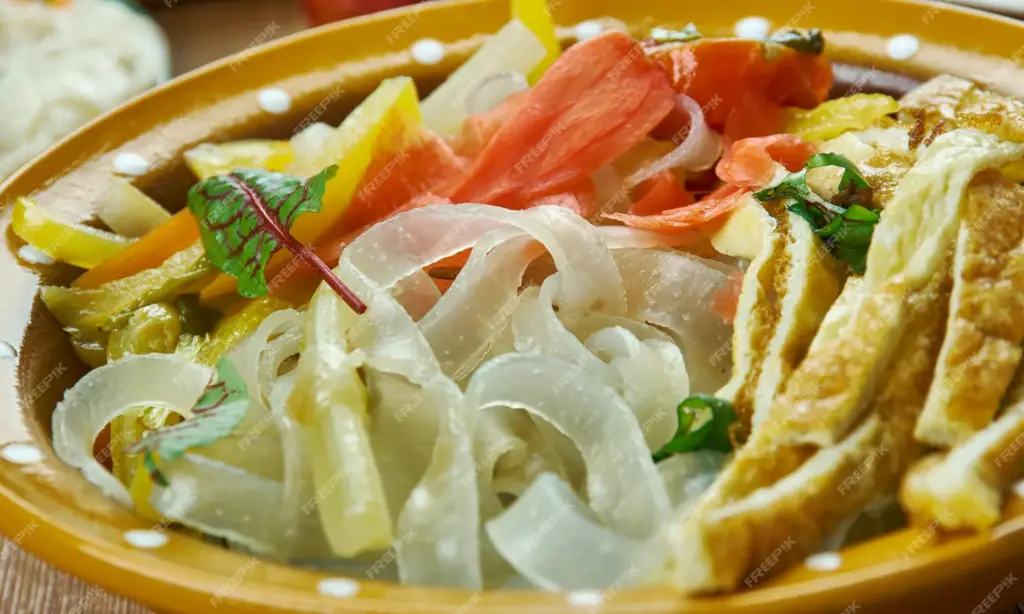
Ashlyamfu, a beloved dish of Kyrgyzstan, hails from the Lake Issyk-Kul region. The lake itself, is the second-largest alpine lake in the world. It is a crossroads of cultures, and a melting pot of traditions and trades. The region’s cuisine reflects this.
Locals describe Ashlyamfu as a refreshing cold noodle dish. It is a perfect antidote to the hot summers of the region. Given the nature of the dish and the area’s somewhat limited agricultural capabilities, it’s believed that Ashlyamfu evolved as an innovative way to use readily available ingredients to produce a dish that’s both satisfying and refreshing. The dish’s tangy flavors and unique textures make it a favorite, not just in its place of origin but across Kyrgyzstan.
The dish is also known for its communal nature, often being prepared in large quantities for festivals, gatherings, or any significant event. The act of preparing and consuming Ashlyamfu becomes a social event, a testament to the Kyrgyz people’s communal and sharing nature.
Kyrgyz Cuisine – Ingredients for Ashlyamfu
- Handmade noodles (preferably from rice or wheat)
- Vinegar (to taste, but typically about 3-4 tablespoons)
- 3-4 chili peppers (adjust based on your heat preference)
- 3-4 cloves of garlic, finely minced
- 2-3 boiled eggs for garnish
- Salt, to taste
- Fresh herbs (like dill or cilantro) for garnish
Kyrgyz food Recipes for Ashlyamfu
Preparing the Noodles
- Begin by preparing the dough for the noodles. Combine your choice of flour (rice or wheat) with water to form a soft yet pliable dough.
- Roll out the dough thinly on a floured surface and cut into thin, long strips.
- Allow these noodle strips to dry for a couple of hours.
- Boil a large pot of water with a pinch of salt. Once boiling, add the noodles.
- Cook until they are soft but still retain a slight bite. This might take around 5-7 minutes, but it’s essential to keep checking to ensure they don’t get too soft.
- Drain the noodles and rinse them under cold water to stop the cooking process.
Preparing the Sauce
- In a mortar and pestle, crush the chili peppers and garlic into a rough paste. You can also use a food processor or finely mince them with a knife.
- Mix this paste with vinegar and a pinch of salt. Adjust the quantities based on your preference for heat and tanginess.
Assembling the Dish
- In a large mixing bowl, combine the cold noodles and the chili-vinegar mixture. Toss them well and coat the noodles well with the sauce.
- Transfer the noodles to individual serving bowls.
Garnishing and Serving
- Slice the boiled eggs and place them on top of the noodles.
- Sprinkle fresh herbs for added aroma and flavor.
- Serve the dish cold, preferably with a side of fresh salad or pickled vegetables.
The juxtaposition of tangy, spicy, and refreshing elements in Ashlyamfu make it a must-try for anyone keen on exploring the rich tapestry of Kyrgyzstan’s culinary landscape.
Whether you’re trying to beat the summer heat or looking to experience a slice of Kyrgyz culture, Ashlyamfu is the perfect dish to indulge in.
Kyrgyz Cuisine – Kuurdak

Kuurdak, one of the most ancient dishes in Kyrgyzstan, holds a significant place in Kyrgyz culinary traditions. The name “Kuurdak” can be translated as “roasted” or “fried,” and it refers to the method of cooking the dish.
Historically, Kuurdak was prepared by nomads using the meat of an animal they had recently slaughtered, often sheep or cow. The Kuurdak recipe showcases the Kyrgyz people’s resourcefulness, as it uses virtually every part of the animal, emphasizing a nose-to-tail approach.
Being a predominantly nomadic culture, the Kyrgyz had limited ingredients at their disposal while traveling. As such, Kuurdak is a reflection of simplicity and sustenance. It’s not just a dish; it’s a narrative of the Kyrgyz people’s nomadic life, resilience, and deep connection with their livestock.
Kuurdak is traditionally cooked in a kazan, a type of large cast-iron cauldron, over an open flame. It’s a communal dish, meant to be shared, and is often present at large gatherings, celebrations, and family occasions.
Kyrgyz Cuisine – Ingredients for Kuurdak recipe
- 500 grams of mutton or beef (traditionally, organs like liver, lungs, and kidneys are also used)
- 2-3 large onions, sliced
- 4-5 cloves of garlic, minced
- 3-4 large potatoes, peeled and cut into chunks
- Salt, to taste
- Pepper, to taste
- Ground cumin, to taste
- A bunch of fresh coriander (cilantro), finely chopped
- 2-3 tablespoons of cooking oil or animal fat
- Water, as needed
Kyrgyz food – Kuurdak recipe
Kuurdak recipe -Preparing the Meat
- Start by cleaning the meat and cutting it into bite-sized chunks. If using organs, ensure they’re cleaned properly.
- In a large pot or kazan, heat the cooking oil or animal fat. Once hot, add the meat pieces.
- Brown the meat on all sides until it develops a deep golden color.
Adding Aromatics
- Add the sliced onions and minced garlic to the meat. Sauté until the onions become translucent and soft.
Seasoning
- Season the meat and onions with salt, pepper, and ground cumin. Mix well to ensure even seasoning.
Kuurdak recipe – Cooking the Potatoes
- Add the potato chunks to the pot. Stir and mix well, ensuring the potatoes are coated with the seasonings and meat juices.
Kuurdak recipe – Simmering the Kuurdak
- Add enough water to the pot to barely cover the meat and potatoes.
- Let the mixture come to a boil, then reduce the heat and let it simmer. Cover the pot and let the Kuurdak cook for about 30-40 minutes or until the meat and potatoes are tender and the flavors meld together.
Finishing Touches
- Check for seasoning and adjust if necessary. Stir in the freshly chopped coriander.
Kuurdak recipe – Serving
- Serve Kuurdak hot, ideally straight from the kazan. It’s best enjoyed with fresh flatbreads and a side of pickled vegetables or a simple salad.
Kuurdak, with its rich flavors and deep historical roots, offers a taste of the nomadic lifestyle of the Kyrgyz people. Whether prepared over an open flame in the vast Kyrgyz steppes or in a modern kitchen, its essence remains unchanged, making it a timeless classic of Kyrgyzstan cuisine.
Kyrgyz Cuisine – Beshbarmak

Beshbarmak is not just a dish; it’s an emblem of Kyrgyz hospitality and the centerpiece of many a festive occasion. The name “Beshbarmak” translates to “five fingers,” signifying that this dish is traditionally eaten with one’s hands. Deep-rooted in the nomadic culture of the Kyrgyz, Beshbarmak epitomizes the importance of livestock in their way of life.
Historically, in the vast steppes and challenging terrains of Kyrgyzstan, pastoral nomadism thrived. Sheep, horses, and cattle weren’t just livestock; they were companions, assets, and crucial food sources. Beshbarmak evolved as a dish that honored a freshly slaughtered animal by using its meat and broth to create a nourishing, communal meal. It was a dish of celebration, of gratitude, and of shared joy.
Typically made with boiled meat served on a bed of pasta sheets and doused in onion and meat broth, Beshbarmak is a hearty, comforting dish that warms both the body and the soul.
Kyrgyz Cuisine – Ingredients for Beshbarmak
- 500 grams of lamb or beef (you can also use horse meat, which is traditional in some variations)
- 300 grams of fresh pasta sheets (you can use lasagna sheets or make your own dough)
- 2 large onions, finely sliced
- Salt, to taste
- Pepper, to taste
- 2 liters of water
- Fresh herbs (such as dill, parsley, or coriander) for garnish
Kyrgyz food Recipes for Beshbarmak
Preparing the Meat Broth
- Place the meat in a large pot and cover it with water.
- Bring the water to a boil, skimming off any impurities that rise to the surface.
- Once the water is boiling, reduce the heat to a simmer. Add salt to taste.
- Let the meat cook for about 1.5 to 2 hours or until it’s tender and the broth is flavorful.
Cooking the Pasta
- If making your pasta, mix flour, water, and a pinch of salt to form a stiff dough. Roll it out thinly and cut into large rectangles or squares.
- If using store-bought sheets, ensure they’re cut to the right size.
- Once the meat is nearly done, bring the broth back to a rolling boil and cook the pasta sheets in it. This not only cooks the pasta but also enriches it with the meat’s flavor.
- Cook the pasta until it’s al dente, then remove it from the broth, setting aside. Keep the broth warm.
Preparing the Onion Sauce
- In a separate pan, lightly sauté the finely sliced onions until they’re translucent.
- Ladle some of the meat broth into the pan, and let the onions simmer in it until they’re soft and the mixture has a sauce-like consistency.
- Season with salt and pepper to taste.
Assembling Beshbarmak
- On a large serving platter, spread out the cooked pasta sheets.
- Place the boiled meat pieces on top of the pasta.
- Pour the onion sauce over the meat and pasta.
- Finally, ladle more of the hot broth over the entire dish, ensuring the pasta is soaked.
Garnishing and Serving
- Sprinkle fresh herbs over the Beshbarmak.
- Traditionally, Beshbarmak is served hot and eaten communally, with everyone gathered around the dish, often using their hands.
Beshbarmak is more than just sustenance; it’s an experience, a tradition, and a celebration of Kyrgyzstan’s rich heritage. Whether enjoyed in a yurt under the vast Kyrgyz sky or in a modern dining room, the spirit of Beshbarmak remains unaltered, symbolizing unity, gratitude, and the joys of shared meals.
Kyrgyz Cuisine – Manty

Manty, often described as the Central Asian take on dumplings, holds a cherished place in the gastronomic tapestry of Kyrgyzstan. These delightful pockets of savory filling, typically meat or vegetables, encapsulate the essence of Kyrgyzstan’s culinary inheritance.
The history of Manty is intertwined with the Silk Road’s legacy, where culinary traditions from diverse regions mingled. It’s believed that the concept of stuffed dumplings traveled from China and was adopted by the Central Asian nomads, who gave it their own twist. Given the nomadic lifestyle of the Kyrgyz, dishes like Manty were practical: they required minimal utensils, were easily portable, and could be cooked over an open fire.
In Kyrgyzstan, Manty is not just everyday food but also a dish of festivity and gatherings. Whether it’s a wedding, a family get-together, or a traditional celebration, Manty often graces the table, signifying abundance and shared joy.
Kyrgyz Cuisine – Ingredients for Manty
The Dough
- 3 cups of all-purpose flour
- 1 cup of water
- 1 tsp salt
The Filling
- 500 grams of lamb or beef, finely minced
- 1 large onion, finely chopped
- 2-3 cloves of garlic, minced
- 1 cup of pumpkin or squash, finely grated (optional)
- Salt and pepper, to taste
- Fresh herbs (like coriander or dill), finely chopped (optional)
For Serving
- Butter (melted)
- Sour cream or yogurt
- Red pepper flakes (optional)
Kyrgyz food Recipes for Manty
Preparing the Dough
- In a large mixing bowl, combine the flour and salt.
- Gradually add water, kneading continuously until you have a firm dough.
- Cover the dough with a cloth and let it rest for 30 minutes.
Preparing the Filling
- In another bowl, combine the minced meat, chopped onions, garlic, grated pumpkin, and herbs (if using). Mix until well combined.
- Season with salt and pepper, adjusting to taste.
Shaping the Manty
- Roll out the rested dough on a floured surface into a thin sheet.
- Using a round cutter or a glass, cut out circles from the dough.
- Place a spoonful of the meat mixture in the center of each circle.
- Fold the dough over the filling, sealing the edges to create a half-moon shape. Alternatively, you can gather the edges at the top, forming a pouch-like shape.
Cooking the Manty
- Prepare a steamer. If you don’t have a traditional steamer, you can use a colander placed over a pot of boiling water. Ensure that the water doesn’t touch the Manty.
- Place the Manty in the steamer, ensuring they don’t touch each other to prevent sticking.
- Cover and steam for about 25-30 minutes or until the dough becomes translucent and the filling is thoroughly cooked.
Serving
- Serve Manty hot, drizzled with melted butter.
- Accompany with sour cream or yogurt and a sprinkle of red pepper flakes for those who prefer a little heat.
Manty, with its soft exterior and juicy filling, is a dish that warms the heart as much as the palate. It’s a reflection of Kyrgyzstan’s hospitality, where food is not just nourishment but an act of love and sharing. Whether enjoyed in the chilly environs of a Kyrgyz winter or as a treat in a bustling urban setting, Manty remains a beloved link to a rich and storied past.
Kyrgyz Cuisine – Shashlik

Shashlik, or skewered meat, is a culinary tradition that echoes through many countries, but its rendition in Kyrgyzstan is especially flavorful and beloved. Rooted deep in the nomadic lifestyle of the Central Asian steppes, shashlik is a testament to the simplicity and efficiency of Kyrgyz cooking.
The history of shashlik in Kyrgyzstan goes hand in hand with the pastoralist way of life. The vast steppes, rolling hills, and majestic mountains of Kyrgyzstan were home to nomads who reared livestock. This abundance of meat, combined with the need for mobile and simple cooking techniques, gave birth to shashlik. Freshly cut chunks of meat were skewered and roasted over open flames or glowing coals, resulting in a dish that’s both rustic and delicious.
Today, shashlik is more than just a dish; it’s a communal experience. Family gatherings, festive occasions, or simple outings often feature a shashlik feast, where skewers sizzle over coals, filling the air with irresistible aromas.
Kyrgyz Cuisine – Ingredients for Shashlik
- 500 grams of lamb or beef (traditionally, fatty cuts are preferred for juicier results)
- 2 large onions, thinly sliced
- 3 cloves of garlic, minced
- 1/2 cup of vinegar (white or apple cider)
- 1 tsp ground coriander
- 1 tsp ground cumin
- Salt and pepper, to taste
- Fresh herbs (like coriander or parsley), for garnish
- Lemon or lime wedges, for serving
- Metal or wooden skewers (if using wooden, soak them in water for 30 minutes to prevent burning)
Kyrgyz food Recipes for Shashlik
Marinating the Meat
- In a large bowl, combine the thinly sliced onions, minced garlic, vinegar, ground coriander, cumin, salt, and pepper. Mix well to form the marinade.
- Cut the meat into roughly 2-inch cubes and add them to the marinade. Ensure the meat pieces are well-coated.
- Cover the bowl and refrigerate for at least 4 hours, preferably overnight, to let the flavors meld.
Preparing the Skewers
- Thread the marinated meat pieces onto the skewers. You can intersperse with pieces of bell pepper or onion for added flavor and color, but traditionally, it’s just meat.
Grilling the Shashlik
- Preheat a grill or barbecue to medium-high heat. If you’re using charcoal, wait until the coals are ash-covered.
- Place the skewers on the grill, ensuring they’re not overcrowded.
- Grill the shashlik, turning occasionally, for about 10-15 minutes or until the meat is nicely browned and cooked to your desired level.
Serving
- Once off the grill, let the shashlik rest for a few minutes.
- Garnish with fresh herbs and serve hot with lemon or lime wedges on the side.
Whether savored under the expansive Kyrgyz sky or in the heart of a bustling city, shashlik remains a dish that brings people together. Its smoky flavors, accentuated by the tangy marinade, create a symphony of tastes that’s quintessentially Kyrgyz. As you bite into a piece of shashlik, you’re not just enjoying a dish, but partaking in a tradition that has withstood the test of time.
Kyrgyz Cuisine – Chak-Chak

Chak-Chak, a sweet, sticky, and delightful treat, is a favorite across Central Asia, including in Kyrgyzstan. Its origins, though contested among various Central Asian nations, have deep roots in the region’s culinary traditions. This delectable sweet treat is made from deep-fried dough drenched in honey or syrup, making it a popular choice for celebrations, gatherings, and especially during the Nowruz (Persian New Year) festivities.
In Kyrgyzstan, Chak-Chak is often associated with joyous occasions. Its golden hue symbolizes prosperity, and its sweetness is believed to bring blessings and happiness. When families come together, it’s not uncommon to find a plate of Chak-Chak being passed around, shared, and enjoyed with a cup of tea.
Kyrgyz Cuisine – Ingredients for Chak-Chak
The Dough
- 3 cups of all-purpose flour
- 3 large eggs
- 1/2 tsp salt
- Water, as needed
The Syrup
- 1 cup of honey
- 1/2 cup of granulated sugar
- 2 tbsp unsalted butter
For Frying:
- Vegetable oil or sunflower oil
Kyrgyz food Recipes for Chak-Chak
Making the Dough
- In a large mixing bowl, combine the flour and salt.
- Add the eggs and mix until a dough starts to form. If the dough is too dry, you can add a little water to bring it together.
- Knead the dough until it’s smooth and elastic. Cover and let it rest for about 30 minutes.
Rolling and Cutting the Dough
- Divide the rested dough into several portions. Roll each portion into a long, thin rope about the thickness of a pencil.
- Cut the ropes into small pieces, roughly 1 cm in length.
Frying the Dough
- Heat the oil in a deep frying pan or pot. To check if it’s hot enough, drop a small piece of dough into the oil; it should sizzle and rise to the surface.
- Fry the dough pieces in batches until they’re golden brown. Remove with a slotted spoon and drain on paper towels.
Making the Syrup
- In a saucepan, combine the honey, sugar, and butter. Heat over medium flame until the sugar dissolves and the mixture starts to bubble. Reduce the heat and simmer for a few minutes until the syrup thickens slightly.
Combining Everything
- Place the fried dough pieces in a large bowl. Pour the hot syrup over them, ensuring all the pieces are well-coated.
- While the mixture is still warm, shape it into a mound or any desired shape, pressing the pieces together.
Serving
- Allow the Chak-Chak to cool and set. Once firm, it can be cut into pieces and served.
Chak-Chak is a sweet indulgence that carries with it the heart of Kyrgyz celebrations. Its crispy texture combined with the sticky sweetness of the honey syrup creates a treat that’s hard to resist. As you relish this golden delight, you’re not only enjoying a culinary masterpiece but also partaking in a long-standing Kyrgyz tradition of celebrating life’s sweet moments.
Kyrgyz Cuisine – Boorsok

Boorsok, sometimes referred to as the “bread of the Kyrgyz,” is an integral part of the culinary heritage of Kyrgyzstan. These small pieces of deep-fried dough are not just a delight to the taste buds but also carry with them a rich tapestry of cultural significance.
Originating from the nomadic lifestyles of the Kyrgyz people, boorsok was an ingenious way to preserve bread. Freshly made dough, fried until golden, could last for days, making it an excellent travel companion across the vast steppes. Moreover, the simplicity of its ingredients ensures that boorsok can be made almost anywhere, from mountainous terrains to open pastures.
Today, boorsok is a staple at Kyrgyz celebrations. It’s customary to throw pieces of boorsok into the air during festivities, symbolizing distribution of luck and happiness.
Kyrgyz Cuisine – Ingredients for Boorsok
- 4 cups of all-purpose flour
- 1 cup of milk (warm)
- 1 large egg
- 2 tbsp unsalted butter, melted
- 2 tsp sugar
- 1 tsp salt
- 1 tsp baking powder
- Vegetable or sunflower oil, for frying
Kyrgyz food Recipes for Boorsok
Preparing the Dough
- In a large bowl, combine the flour, sugar, salt, and baking powder.
- Make a well in the center and add in the warm milk, melted butter, and egg. Begin mixing to form a cohesive dough.
- Knead the dough for about 10 minutes until smooth and elastic. Cover with a damp cloth and let it rest for 30 minutes to an hour.
Shaping the Boorsok
- After resting, divide the dough into smaller portions. Roll each portion into a thin sheet, about a quarter-inch thick.
- Cut the sheet into small rectangles or triangles, roughly 2-3 inches in size.
Frying the Dough
- Heat the oil in a deep frying pan or pot. The oil is ready when a small piece of dough sizzles upon contact.
- Fry the boorsok pieces in batches, ensuring not to overcrowd the pan. They should puff up slightly and turn golden brown.
- Once golden on both sides, remove with a slotted spoon and drain on paper towels.
Serving
- Boorsok is at its best when it is warm. Yiu can serve it as a snack, paired with tea, or even as a side dish with main courses, especially soupy dishes.
In the heart of Kyrgyzstan, boorsok is more than just a fried bread. It’s a symbol of hospitality, tradition, and the timeless beauty of nomadic culture. Each bite is a reminder of the vast landscapes, the mountainous horizons, and the warm-hearted people of this beautiful nation.
Conclusion
Kyrgyz food Recipes are a mirror to its rich culture, history, and environment, is a testament to the nation’s undying spirit and love for food. From the hearty starters to the sumptuous main courses and delightful desserts, every dish tells a story, making [Kyrgyzstan cuisine] a delightful journey worth exploring.
FAQ’s
What is the Kyrgyz National Food?
The Kyrgyz national food, also known as “beshbarmak,” is a traditional dish consisting of boiled meat, typically lamb or beef, served on a bed of homemade pasta. It is often accompanied by onions, potatoes, and a savory broth.
Beshbarmak is not only a delicious meal but also an important part of Kyrgyz culture and hospitality.
Is Kyrgyz cuisine predominantly meat-based?
Yes, given the country’s nomadic past and cold climate, meat, especially lamb, beef, and horse, plays a central role.
How do Kyrgyz people view communal eating?
Communal eating is essential, reflecting the significance of community and togetherness.
Are there vegetarian Kyrgyz food Recipes?
While traditionally meat-heavy, there are vegetable-based dishes and modern vegetarian adaptations in urban areas.
What influences Kyrgyz food Recipes traditions the most?
The nomadic past, agricultural practices, and neighboring nations greatly influence its cuisine.
Which drink is popularly consumed with meals?
Tea, both black and green, is a staple, along with fermented beverages like kumis.
Are spices heavily used in their Kyrgyz food Recipes?
While flavorful, Kyrgyz cuisine doesn’t rely heavily on spices but rather on the natural flavors of ingredients.

